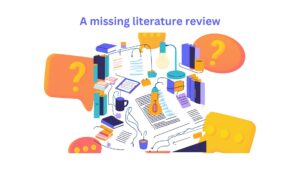The Scenario
A student recently brought me their dissertation proposal for feedback. They had observed a phenomenon, discussed it with their professor, who pointed them to two or three references and worked on this limited basis. In fairness, the student acknowledged they still had work to do on the literature, but their proposal was already missing key elements.
The Issue
A strong literature review provides more than background information—it anchors a study in existing research, identifies gaps, and justifies why the study is necessary. Importantly, it also provides the theoretical basis for the study.
In this case, the student’s proposal had three key issues:
- Lack of Context: The study was not grounded in past research beyond the few sources cited. Without this foundation, the proposal read as if the student were working in isolation rather than building on existing knowledge.
- Weak theoretical grounding: The proposal lacked a theoretical or conceptual framework. A strong study requires more than just a research question—it needs a guiding framework that explains relationships between variables and provides a structure for analysis. Without this, the research lacked a scholarly base.
- No Identified Knowledge Gap – The student had not articulated what had already been studied nor how their research would contribute to the field. We did a quick Google Scholar search during our meeting and found several studies on the topic, much to their dismay. However, one can almost always find a gap, and we found it – most of the studies had been conducted during the COVID-19 pandemic, with few examining the post-pandemic landscape. Here was their opportunity, although they needed to confirm this with a more thorough search. A well-conducted literature review would help the student recognize this research opportunity or some other one.
The Lesson
To avoid these pitfalls, consider the following steps:
- Conduct a Comprehensive Literature Search
- Use academic databases such as Google Scholar, PubMed, or Scopus.
- Go beyond the first few search results—dig deeper.
- Use AI tools like Research Rabbit or Connected Papers to map related studies.
- Identify the Knowledge Gap
- What has already been studied?
- Where are the inconsistencies or limitations in past research?
- What new perspectives or contexts could your study explore?
- Justify Your Research Contribution
- Explicitly state how your study builds on or challenges existing research.
- Position your study within the academic conversation rather than as an isolated effort.
- Avoid Over-Reliance on a Few Sources
- While guidance from professors is valuable, supplement their recommendations with your own research.
- Use systematic review techniques, such as a summary matrix, to track themes and gaps across studies.
The Key Takeaway
A well-researched literature review is not just a formality—it is the foundation of a credible and impactful study with a sound theoretical base. Without it, you risk duplicating existing research or failing to make a meaningful, scholarly contribution. Take the time to explore the literature thoroughly; the gaps and opportunities will reveal themselves.
I’m happy to help you individually or in one of my group programs if you need support on your dissertation or data analysis. My Back to Academia program provides step-by-step guidance, starting in the next few weeks. I’d love to see you there.
Contact me at [email protected] if you need further information or help with your statistical analysis or any aspect of your dissertation.
